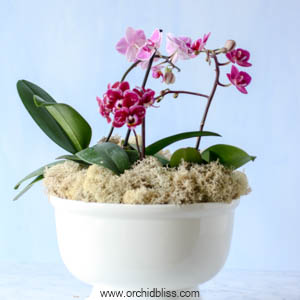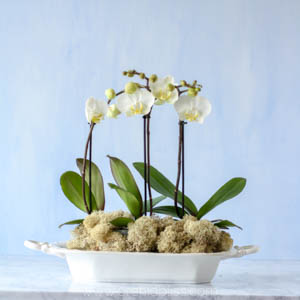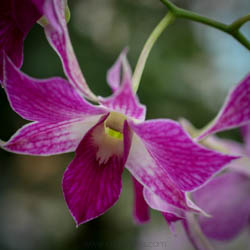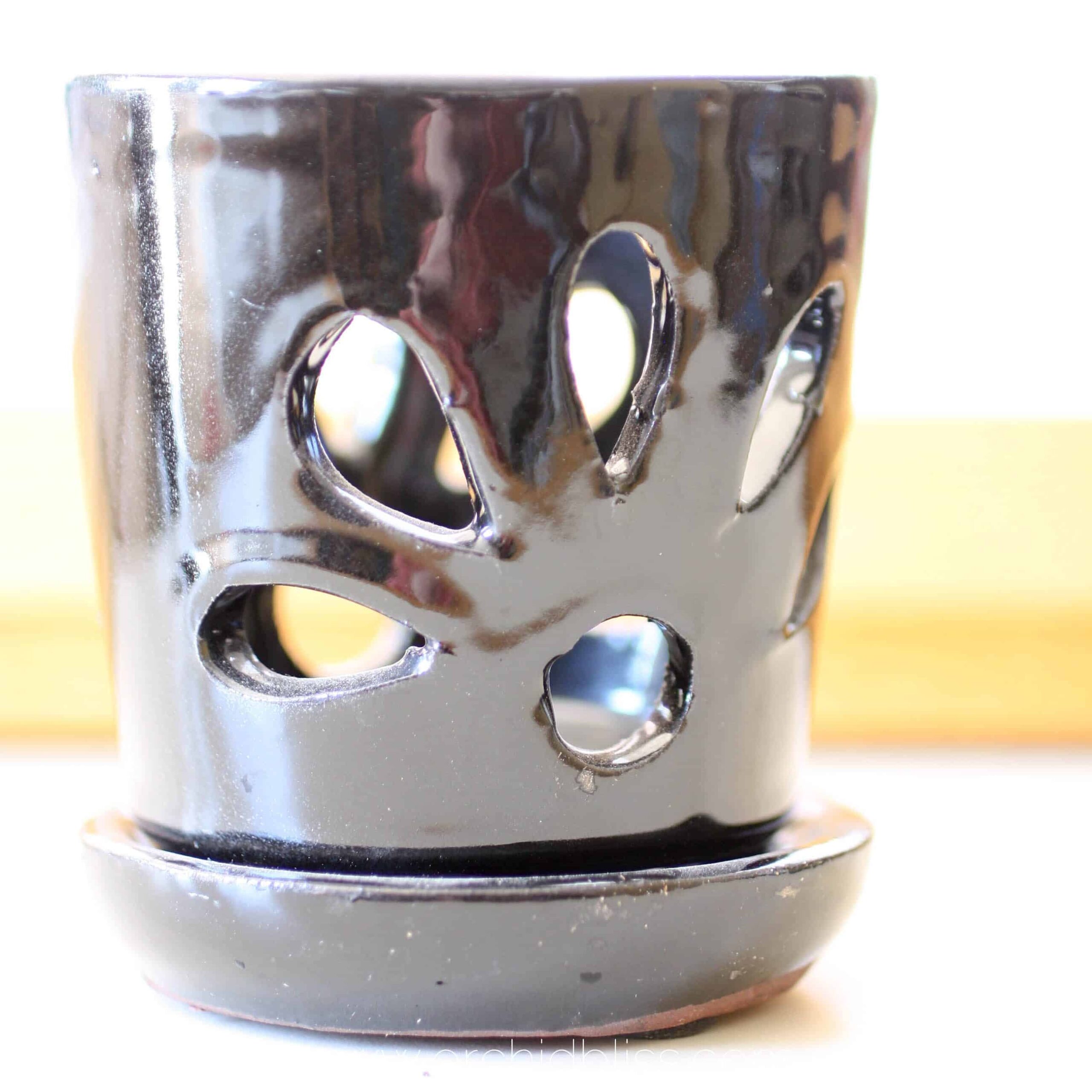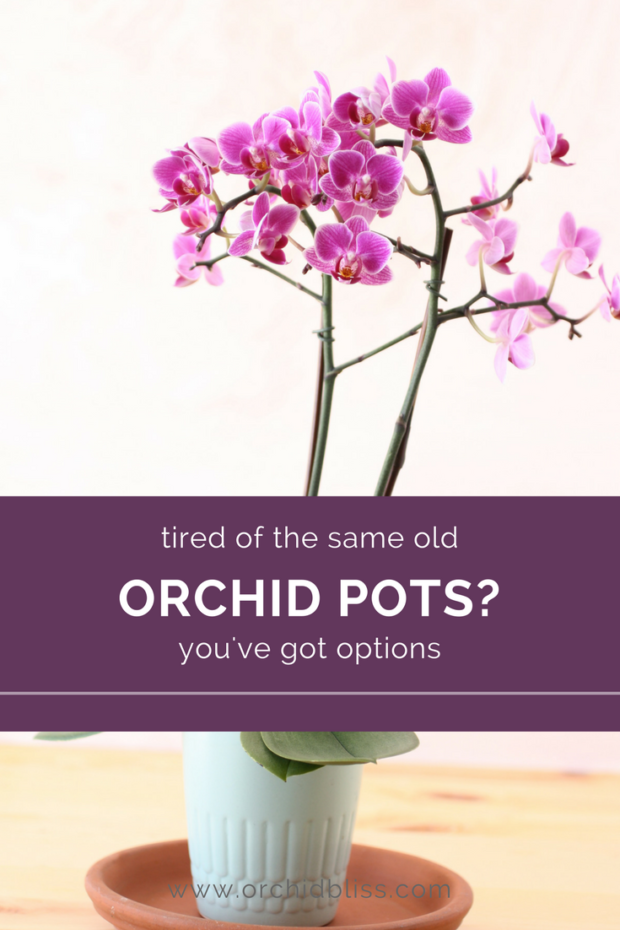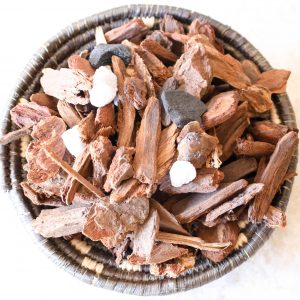
Need help solving orchid watering problems? You’ve come to the right place. Learn how to take the guesswork out of watering orchids by choosing the right pot.
The right orchid pot will complement your orchid’s growing environment. When choosing orchid pots you have 6 main options:
- Clear plastic
- Opaque plastic – a black grower pot
- Terracotta
- Pottery and ceramic pots with drainage holes
- Pottery and ceramic with holes in the bottom and sides
- Mounted and kokedama
In this post, we will discuss the advantages and disadvantages of each type of orchid pot. This way you can make an informed decision based on your growing environment. The orchid pot, the potting mix, and the humidity in the air all have an enormous impact on how frequently your orchid will need water.
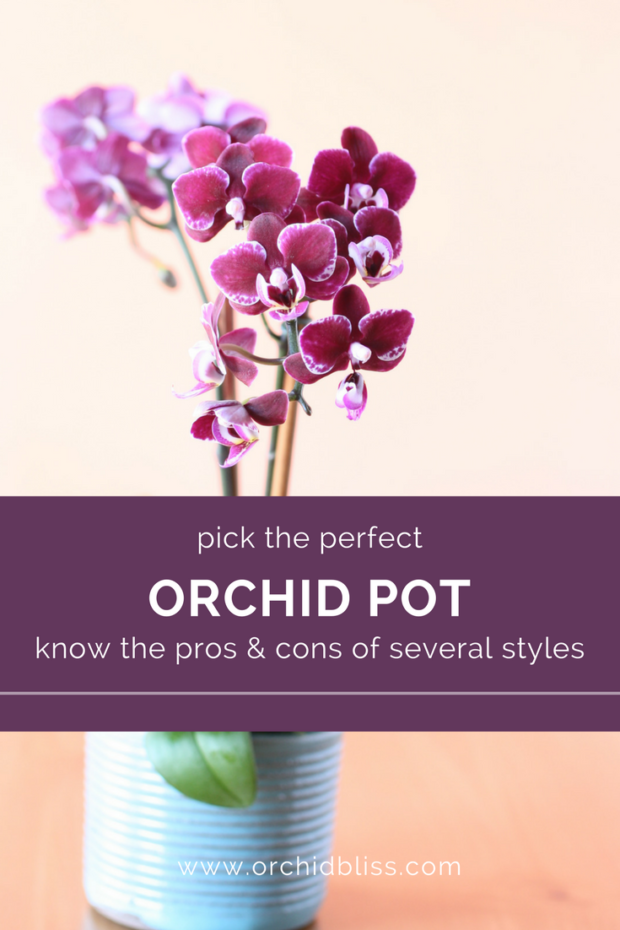
Some of the links on this page may be affiliate links. Click here to learn more.
Clear Plastic Orchid Pots
One option is to plant your orchid first in a clear plastic pot that is set inside an outer pot. You’ll want the outer pot to be narrower at the base than the plastic pot so that excess water will drain out of the clear inner pot into the outer pot. This will keep the orchid’s roots from sitting in water. The clear plastic serves as the window to the orchid’s roots and potting medium and the outer pot discourages algae from growing.
You may be wondering, why are orchids grown in clear pots? This is especially baffling when you can use a beautiful piece of pottery. The answer is all about visibility.
Clear Orchid Pots Help with Watering
In a clear pot, the grower can easily see if the planting medium is drying out, or if it is still wet. With a clear pot, water condensation on the sides of the pot is easily visible.
Clear Orchid Pots Let’s You See the Orchid’s Roots
Another reason orchid growers like clear pots are that the health of the roots can also be easily ascertained. Brown and mushy are dead, overwatered roots. Wet roots are bright green. Silvery roots are healthy, but not wet. Green or red root tips are healthy.
TIP: In addition to being clear, orchid pots should also have holes or slots. This allows for water drainage and air circulation.
I like to use RePotMe‘s clear pots because they are heavy-duty and have lots of slots that provide air circulation to the orchid’s roots and water drainage.
What About Stability?
Setting the plastic pot in a secondary pot will add stability to the orchid as plastic is lightweight and orchids tend to be top-heavy. Additionally, you can choose an attractive outer pot, enhancing the overall appearance of your orchid. The grower will then need to lift the plant out of the outer pot to see what is going on with the roots an potting mix. Together, the plastic inner pot and the ceramic out pot create form and function.
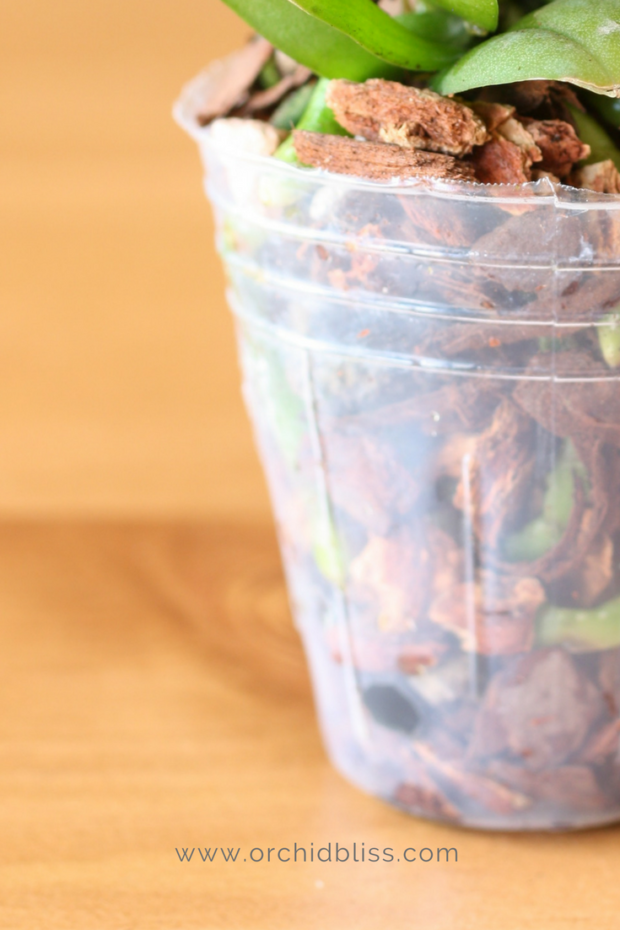
Use a clear plastic pot as a liner, which is then set inside an outer pot. This way, you can easily check to see if the roots are healthy and if the plant needs water.
Opaque Plastic Orchid Pots
I have several orchids that have come in an opaque plastic pot. When the plants come like this, I wait until they have finished blooming and then I re-pot them. As stated above, my preference is to re-pot in a clear plastic pot and then to set the plant in a secondary clay pot.
Use extra care when switching a Dendrobium from an opaque to a clear pot. These orchids do not like their roots disturbed. Before making the switch, be sure the Dendrobium is growing new roots, then quickly, lift the orchid out of the opaque pot and set it into the new clear, plastic pot. Keep the roots and potting media as intact as possible.
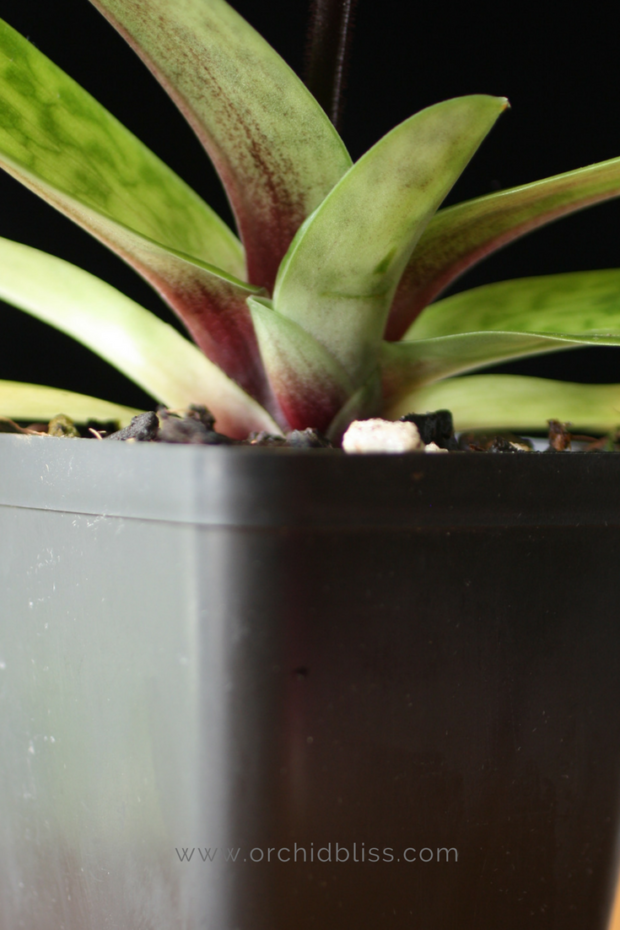
Terracotta Orchid Pots
Terracotta is another popular choice. It is inexpensive and looks nice. I actually like the look of the water mineral stains that build-up on the sides. The downside is that orchid roots cling to the sides, making re-potting more of a challenge–and you can’t just lift the orchid out of the pot to see the roots.
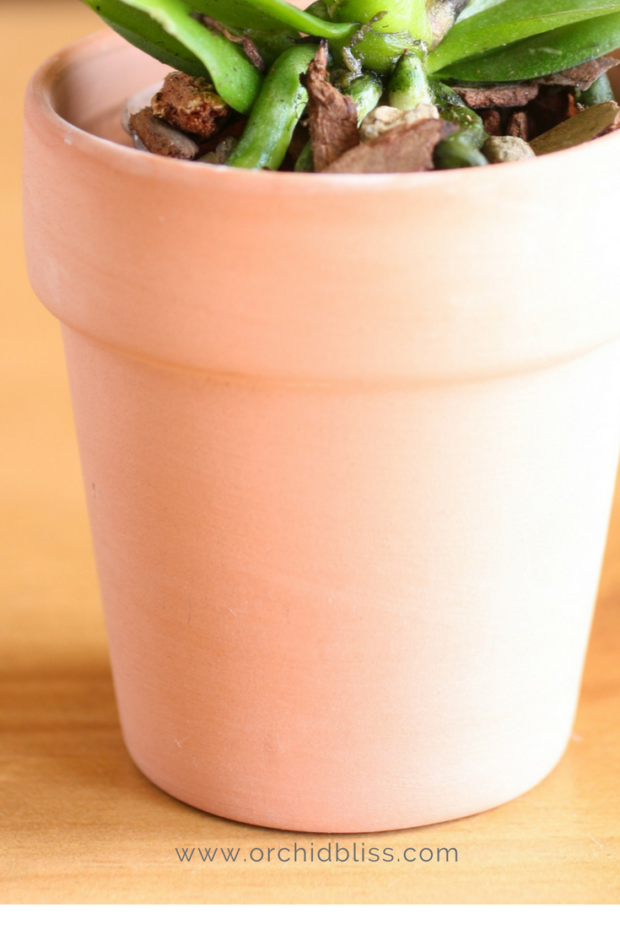
Terracotta is an inexpensive and popular choice for potting orchids.
Glazed Pottery and Ceramic Orchid Pots
There are so many beautiful pots that it is hard to resist using these to house our orchids. There is something very special about a piece of hand-thrown pottery. It’s art. Unlike a terracotta or a plastic pot, pottery can be pricey.
Decorative orchid pots can be used as a secondary pot with clear plastic housing the orchid, making it easy to inspect the roots and the moisture content. I like the base of the pottery to be narrower than the plastic pot so that the plastic pot sits above the base of the pottery. This ensures that excess water will drain out the plastic pot and catch in the secondary pot while keeping the orchid’s roots out of the water.
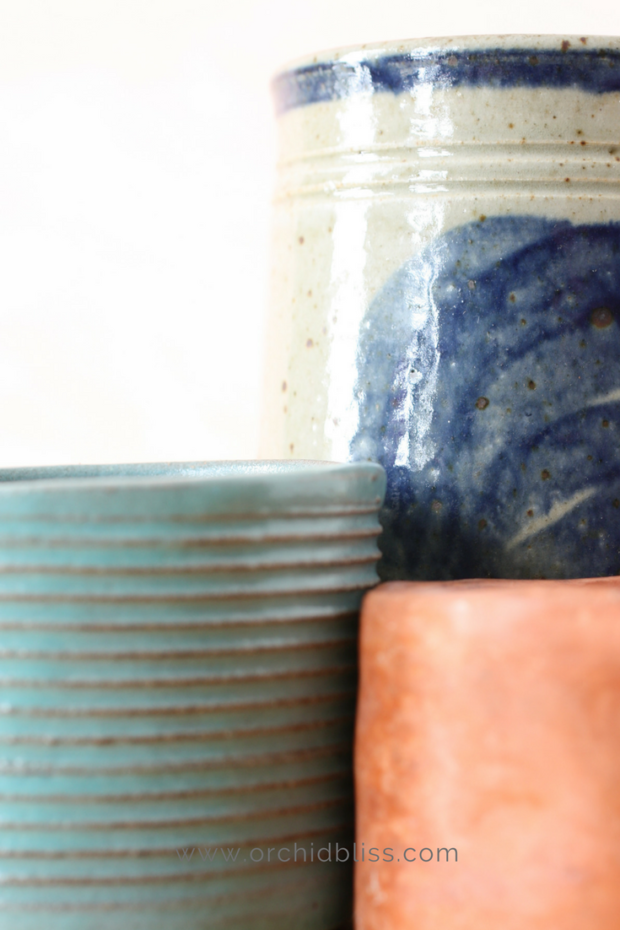
Orchid Pots with Holes
When many of us think of orchid pots we think of pots with a lacework of holes in the side of the pot which allow for air circulation around the roots. It is also easy to see how the roots are doing and to check for moisture.
When purchasing one of these pots make sure that the holes aren’t too big. You don’t want the potting media to come out when watering. When you do water, be sure to set the pot in a deep saucer or over a drain to catch the water that runs out. When watering, water deeply. The drainage holes keep the orchid from sitting in water.
When using these pots, do not use a clear liner pot. If the orchid soil obstructs your view of the orchid’s roots, use the dampness, or dryness, of the orchid’s potting medium as your watering guide. These pots come in a wide variety of colors. You can purchase hand potted or mass-produced pots, but they are usually all made from ceramic. Handmade pottery is gorgeous but comes with a price tag. When watering with one of these pots, you may want to set the orchid in another, larger pot while the potting medium absorbs water. Be sure the larger pot is scrupulously clean to avoid inadvertently spreading disease.
If you are looking for hand-thrown pottery, I recommend Pottery by Jolene. Her pots come with a removable saucer, which I consider essential. I don’t like the attached saucers because they don’t drain a well as removable saucers. The potter, Jolene, grows orchids and tests her pots on her own plants.
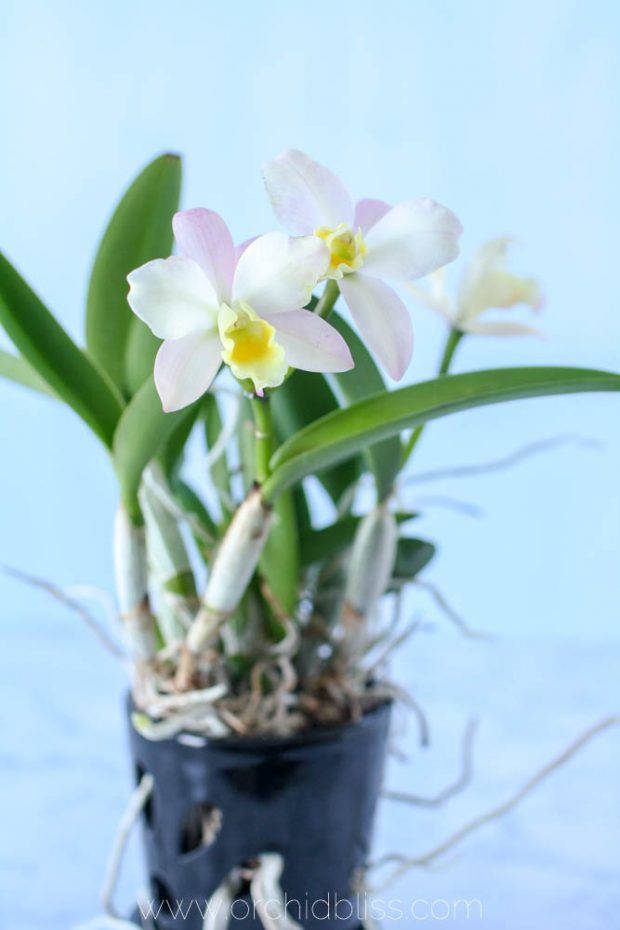
Check out the roots of this Cattleya. If you grow an orchid in a pot with holes. This is what will happen. If crazy roots aren’t for you, you may want to consider a different type of pot. If you’ve embraced wild orchid roots, then this type of pot will suit you.
TIP: Note that the Cattleya is growing in a dark-colored pot. If you’re growing an orchid with high light requirements, like the Cattleya, you may want to do what I do, and grow under lights. I don’t grow all my orchids under lights, but I’ve found that my Cattleyas do best under lights where they can get lots of light, but not a lot of heat. I have some Paphiopedilums under in dark-colored pots, but they do fine as they are considered a low-light orchid.
Mounted Orchids
In its natural habitat, most orchids grow on trees and on rocks, and a few in the soil. An orchid growing on a slab of wood can really make a statement. These plants can require high humidity levels and needs to be watered from above. Or, you can soak a mounted orchid in a large bowl or basin of water.
Trays and Baskets
If you would like to create an arrangement for your orchids, a wide, shallow tray or basket will do the trick. When making an orchid display, I leave the orchids in the pots they came in (both the plastic and the pottery) and set them in the tray. To fill in gaps I place prepackaged moss between pots.

To learn how to pot multiple orchids in a single pot, click here.
Final Thoughts
Choosing the best the pot for your orchid will do more than maximize the orchid’s visual appeal.
If possible, use an inner clear plastic pot with plenty of drainages that will aid you in the care and maintenance of your orchid. Then, finding just the right outer pot will showcase your orchid as the living sculpture that it is.
A well-chosen pot can make the difference between an orchid and AN ORCHID.
Keep your orchids looking their best. Here’s how to prevent limp, leathery leaves and rotten roots. Download my free cheat sheet on how to prevent limp leaves and rotten roots. Click here for the super helpful cheat sheet.
Protect Orchid Roots: Use Pots with Drainage Holes
Orchids do not like to sit in water. Adequate drainage is a must. End of story. 🙂
Protect Surfaces: Use a Saucer
To protect surfaces, I recommend using saucers. This will prevent water rings on furniture and window sills. Adding creative saucers are like fun accessories. The saucer pictured below was marketed as a catch-all for jewelry.

